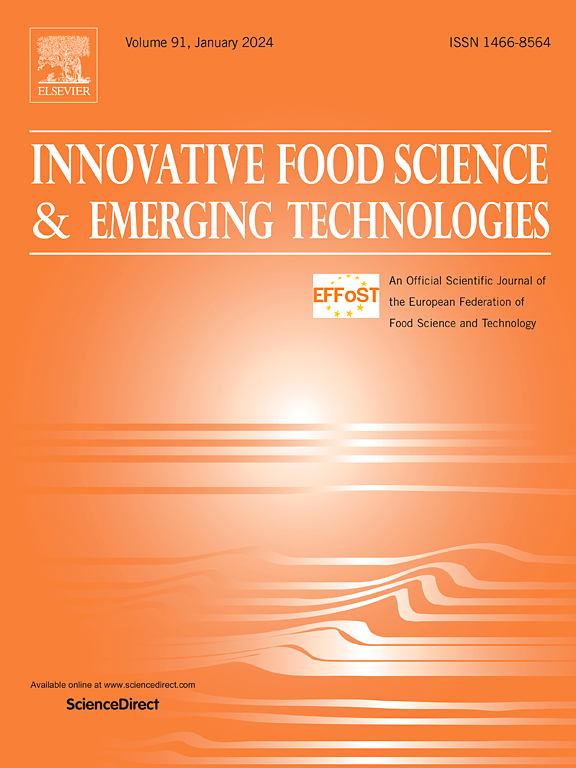Influence of nixtamalization time and solid-state fermentation on masa starch: Morphology, structure, and physicochemical properties
IF 6.3
1区 农林科学
Q1 FOOD SCIENCE & TECHNOLOGY
Innovative Food Science & Emerging Technologies
Pub Date : 2025-05-10
DOI:10.1016/j.ifset.2025.104038
引用次数: 0
Abstract
In this paper, the effect of two cooking times of nixtamalization (30 and 90 min) and solid-state fermentation masa was investigated. The morphological analysis of the starch grains showed that longer nixtamalization times (90 min) lead to greater damage. The reducing sugars content increased 5.9 times at 90 min compared to 30 min nixtamalization during solid-state fermentation (SSF). The pH value at the end of SSF was below 4.5 for both nixtamalization times. In terms of the thermal properties, it was observed that at 90 min of nixtamalization, the starch granules presented greater gelatinization degree (50.94 %). Furthermore, in the SSF decreased maximum viscosity 4.8 times at 90 min than 30 min. The X-ray diffraction pattern showed nanocrystals with orthorhombic crystal structure in starch, relative crystallinity decreased at 0.9354 and 0.876 in the 30 and 90 min of nixtamalization respectively with SSF. Finally, infrared spectrum, changes were observed in the starch groups of the masa. In conclusion, the nixtamalization time changed the morphology, the production of reducing sugars and lactic acid, thermal properties, and viscosity during SSF, possibly due to the changes that the starch undergoes, making it more susceptible to the enzymatic activity of the microorganisms as lactic acid bacteria mainly.
发酵时间和固态发酵对玛莎淀粉的影响:形态、结构和理化性质
本文研究了两种蒸煮时间(30min和90min)和固态发酵对发酵效果的影响。形态学分析表明,处理时间越长(90 min),损伤越大。在固态发酵(SSF)中,90 min的还原糖含量比30 min的还原糖含量增加了5.9倍。在两种情况下,SSF结束时的pH值都低于4.5。热性能方面,观察到在nitamization 90min时,淀粉颗粒的糊化程度较高(50.94%)。此外,SSF在90 min时最大黏度比30 min时降低4.8倍。x射线衍射图显示淀粉具有正交晶型结构的纳米晶体,相对结晶度在SSF中和30 min和90 min时分别降低了0.9354和0.876。最后,通过红外光谱分析,观察了masa淀粉基团的变化。综上所述,蒸煮时间改变了淀粉在蒸煮过程中的形态、还原糖和乳酸的生成、热性能和粘度,这可能是由于淀粉本身发生了变化,使其更容易受到以乳酸菌为主的微生物酶活性的影响。
本文章由计算机程序翻译,如有差异,请以英文原文为准。
求助全文
约1分钟内获得全文
求助全文
来源期刊
CiteScore
12.00
自引率
6.10%
发文量
259
审稿时长
25 days
期刊介绍:
Innovative Food Science and Emerging Technologies (IFSET) aims to provide the highest quality original contributions and few, mainly upon invitation, reviews on and highly innovative developments in food science and emerging food process technologies. The significance of the results either for the science community or for industrial R&D groups must be specified. Papers submitted must be of highest scientific quality and only those advancing current scientific knowledge and understanding or with technical relevance will be considered.

 求助内容:
求助内容: 应助结果提醒方式:
应助结果提醒方式:


